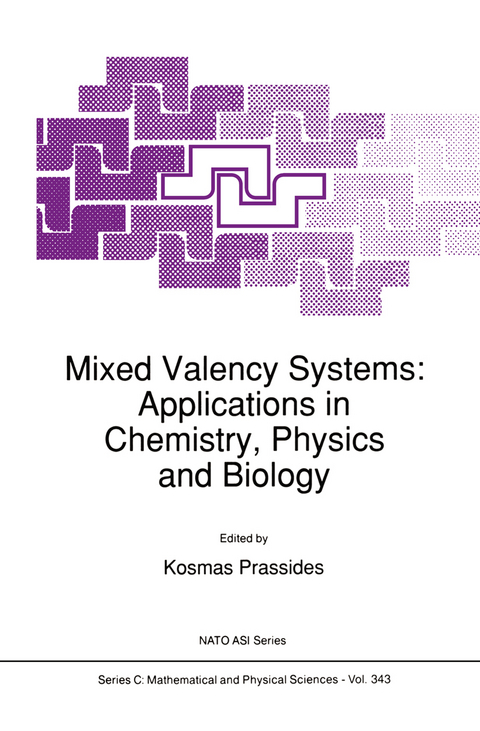
Mixed Valency Systems: Applications in Chemistry, Physics and Biology
Springer (Verlag)
978-94-010-5599-4 (ISBN)
Mixed Valency Systems: Retrospect And Prospect.- Vibronic Coupling Models Of Mixed Valency: Relation Of The PKS And MO Models For One- And Two-Electron Systems.- Electric Field Perturbation Of Electronic (Vibronic) Absorption Envelopes: Application To Characterization Of Mixed Valence States.- Solvent And Temperature Effects In Mixed Valence Chemistry.- Electron Transfer In Mixed Valence Complexes In The Solid State.- Photoredox Chemistry Of Two-Electron Mixed Valence Systems.- How To Design Fast Two-Electron Transfer Reagents: 37-Electron Mixed Valence Fe(I)Fe(II)-Bisandwiches As Key Intermediates.- Magnetic And Optical Phenomena In Biological Iron-Sulfur Mixed Valence Complexes And Their Chemical Models. A Theoretical Approach.- Mixed Valency In Multinuclear Manganese Enzymes And Clusters.- Mixed Valence Iron And Chromium Fluorides. Bronzes And Related Compounds. Chemistry, Structure And Magnetism.- Mixed Valency Minerals: Influences Of Crystal Structures On Optical And Mössbauer Spectra.- Valency Disproportionation In Inorganic Solids.- Superconductivity By Local Pairs (Bipolarons) In Doped Metal Oxide Semiconductors.- A Comparison Between Conducting C.T. Crystalline Salts And L.B. Films.- Optical Spectroscopic Probes Of Mixed Valence Systems.- Inelastic Neutron Scattering Studies Of Mixed Valency Systems.- Mössbauer Emission Spectroscopy Of Mixed Valency After Nuclear Decay In Iron Complexes.- Intramolecular Electron Transfer. Applications In Molecular Electronics.- Vibronic Coupling Models For Mixed Valence Line Shapes: Going Beyond The PKS Approach.- Mixed Valency Oligomers: Model Pathways For The Control Of Their Properties.- The Effects Of Second Order Vibronic Coupling On The Symmetric Dimer And Trimer.- Semiclassical Approach To The Vibronic Problem For TheCreutz-Taube Ion.- A New Spin Hamiltonian For Mixed Valence Systems Including Transfer, Exchange And Exchange-Transfer Terms.- An Example Of The Influence Of The Ligand Held On The Electron Localisation: The Mixed Valence Ferrocene-Ferricinium.- A First Stable Organometallic Analogue [mer(OC)3(PiPr3)2W(?-pyrazine)W(PiPr3)2(CO)3]+ Of The Creutz-Taube Ion. Similarities And Differences.- Mixed Valence Manganese Carboxylates Of Various Nuclearities.- Spectroscopic Studies Of Spin State And Electron Delocalization In A Binuclear Mixed Valence Fe(II/III) Complex.- Bis(Phthalocyaninato) Lanthanide Sandwich Compounds Exhibiting Mixed Valence Ligands.- The Ruthenium Blues.- Optical And Related Properties Of Metal-Halide Chain Compounds: Bulk And Small Particles.- Dielectric Relaxometry: Manganate (VI)-(VII) In Solid And Solution States.- Electronic Instabilities Of Two-Dimensional Metals, K3Cu8S6 And Rb3Cu8S6.- Chemistry And Properties Of New Examples Of Mixed Valence Compounds, Based On Organic ? Donor Molecules And Polyoxometalate Ions.- Mixed Valency In The Organic-Inorganic Compounds (BEDT-TTF)6Cu2Br6 And (BEDT-TTF)6Cu2Cl2Br4.- Electrochemical Generation Of Mixed Valency Copper Complexes In Solution.- Endor Determination Of Proton Hyperfine Tensors As Local Probes Of The Delocalization Of The Spin Population In The 4 Iron — 4 Sulfur Cubanes.- Theory; Descriptions Of Mixed Valency.- Electron Transfer Mechanisms, From Dimers To Infinite Solids.- Applications: Energy Storage And Molecular Electronics.- Biology: Models And Proteins.
| Erscheint lt. Verlag | 23.10.2012 |
|---|---|
| Reihe/Serie | NATO Science Series C ; 343 |
| Zusatzinfo | IX, 451 p. |
| Verlagsort | Dordrecht |
| Sprache | englisch |
| Maße | 155 x 235 mm |
| Themenwelt | Sachbuch/Ratgeber ► Natur / Technik ► Garten |
| Naturwissenschaften ► Biologie ► Biochemie | |
| Naturwissenschaften ► Chemie ► Anorganische Chemie | |
| Naturwissenschaften ► Chemie ► Physikalische Chemie | |
| Naturwissenschaften ► Physik / Astronomie ► Festkörperphysik | |
| Naturwissenschaften ► Physik / Astronomie ► Thermodynamik | |
| ISBN-10 | 94-010-5599-8 / 9401055998 |
| ISBN-13 | 978-94-010-5599-4 / 9789401055994 |
| Zustand | Neuware |
| Informationen gemäß Produktsicherheitsverordnung (GPSR) | |
| Haben Sie eine Frage zum Produkt? |
aus dem Bereich


